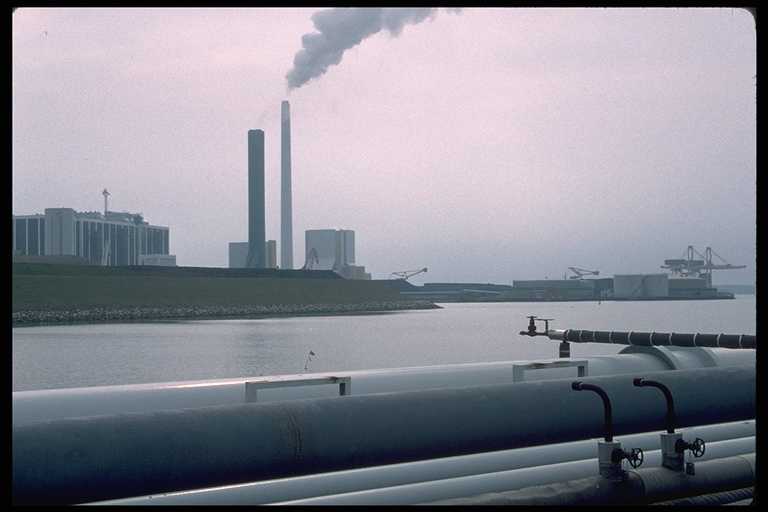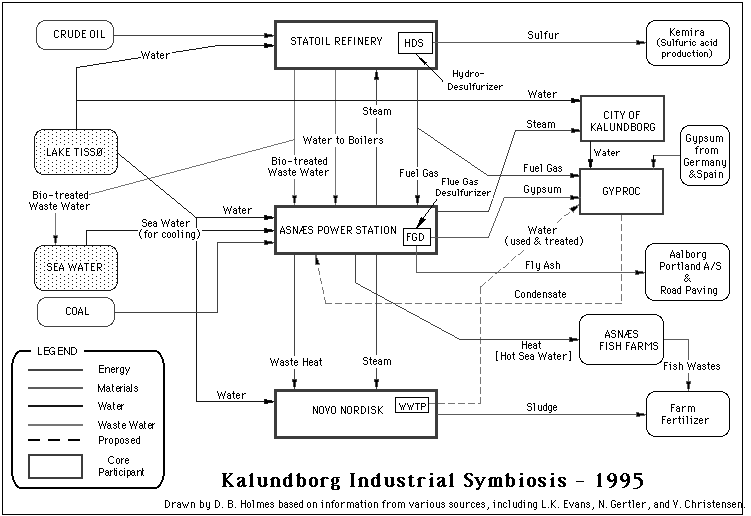Indigo
Development
Creating systems solutions for sustainable development through
industrial ecology
Home | What's New? | Industrial
Ecology | Eco-Industrial Parks
Sustainable Communities | Indigo Services | Indigo
Publications | Site Map
The Industrial Symbiosis
at Kalundborg, Denmark
One of the favorite cases presented by industrial ecologists is
the story of the spontaneous but slow evolution of the "industrial
symbiosis" at Kalundborg, Denmark. This web of materials and
energy  exchanges among companies (and with the
community) has developed over the last 20 years in a small industrial
zone on the coast, 75 miles west of Copenhagen. Originally, the
motivation behind most of the exchanges was to reduce costs by seeking
income-producing uses for "waste" products. Gradually, the managers and
town residents realized they were generating environmental benefits as
well, through their transactions. (A student team working on an
Earth Day project in the early 90s mapped the network of by-product
exchanges with yarn and showed it to the plant managers!)
exchanges among companies (and with the
community) has developed over the last 20 years in a small industrial
zone on the coast, 75 miles west of Copenhagen. Originally, the
motivation behind most of the exchanges was to reduce costs by seeking
income-producing uses for "waste" products. Gradually, the managers and
town residents realized they were generating environmental benefits as
well, through their transactions. (A student team working on an
Earth Day project in the early 90s mapped the network of by-product
exchanges with yarn and showed it to the plant managers!)
The Asnaes Power Station is the hub of the network of materials
and energy by-product exchanges at Kalundborg. The pipes in the
foreground include the conduit for steam to the town of Kalundborg. The
Statoil refinery is to the North, beyond the stacks. Novo Nordisk and
Gyproc plants are about a kilometer to the South.
The Kalundborg system comprises five core partners:
- Asnæs Power Station, Denmark's largest power station,
coal-fired, 1,500 megawatts capacity;
- Statoil Refinery, Denmark's largest, with a capacity of 3.2
million tons/yr (increasing to 4.8 million tons/yr);
- Gyproc, a plasterboard factory, making 14 million square
meters of gypsum wallboard annually (roughly enough to build all the
houses in 6 towns the size of Kalundborg);
- Novo Nordisk, an international biotechnological company, with
annual sales over $2 billion. The plant at Kalundborg is their largest,
and produces pharmaceuticals (including 40% of the world's supply of
insulin) and industrial enzymes; and
- The City of Kalundborg supplies district heating to the
20,000 residents, as well as water to the homes and industries.
Over the last two decades, these partners spontaneously developed a
series of bilateral exchanges which also include a number of
other companies. There was no initial planning of the overall network;
it just evolved as a collection of one-to-one deals that made economic
sense for the pairs of participants in each.
The symbiosis started when Gyproc located its facility in
Kalundborg to take advantage of the fuel gas available from Statoil.
Today, Gyproc is still the only company to have located there to take
advantage of an available supply.
The Kalundborg Network 1995
The following diagram illustrates the network of companies in the
symbiosis, showing the extent of the material and energy exchanges 1995,
currently about 3 million tons per year. Image © Douglas B.
Holmes

Energy Flows
The Asnæs power station is coal-fired and operates at about
40 percent thermal efficiency. Like all other fossil-fuel power
stations, the majority of energy generated goes up the stack. At the
same time, another large energy user, the Statoil refinery flared off
most of its gas by-product.
Then, starting in the early '70s, a series of deals were struck:
- The refinery agreed to provide excess gas to Gyproc, which
had seen Statoil's flares and recognized that this burning gas was a
potential low-cost fuel source.
- Asnæs began to supply the city with steam for its new
district heating system in 1981 and then added Novo Nordisk and Statoil
as customers for steam. The district heating, encouraged by the city
and Danish government, replaced about 3,500 oil furnaces (a significant
non-point source of air pollution).
- The power plant uses salt water, from the fjord, for some of
its cooling needs. By doing so, it reduces the withdrawals of fresh
water from Lake Tissø. The resulting by-product is hot salt
water, a small portion of which is supplied to the fish farm's 57 ponds.
- In 1992, the power plant began substituting fuels, using
surplus refinery gas in place of some coal. This only became possible
after Statoil built a sulfur recovery unit to comply with regulations
on sulfur emission; the gas was then clean enough to permit use at the
power plant.
Materials Flows
In 1976 the Novo-Nordisk plant started the pattern of materials
flows, matching the evolving energy flows at Kalundborg.
- Sludge from Novo Nordisk's processes and from the fish farm's
water treatment plant is used as fertilizer on nearby farm. This is a
large portion of the entire Kalundborg exchange network, totaling over
1 million tons per year.
- A cement company uses the power plant's desulfurized fly ash.
Asnæs reacts the SO2 in its stack gas with calcium carbonate,
thereby making calcium sulfate (gypsum), which it sells to Gyproc,
supplying 2/3 of the latter's needs.
- The refinery's desulfurization operation produces pure liquid
sulfur, which is trucked to Kemira, a sulfuric acid producer.
- Surplus yeast from insulin production at Novo Nordisk goes to
farmers as pig food.
This web of recycling and reuse has generated new revenues and cost
savings for the companies involved and reduced pollution to air, water,
and land in the region. In ecological terms, Kalundborg exhibits the
characteristics of a simple food web: organisms consume each other's
waste materials and energy, thereby becoming interdependent with each
other.
This pattern of inter-company reuse and recycling has reduced
air, water, and ground pollution, conserved water and other resources,
and generated new revenue streams from the byproducts exchanged.
Through 1993, the $60 million investment in infrastructure (to
transport energy and materials) has produced $120 million in revenues
and cost-savings.
Lessons from Kalundborg
What can we learn from the Danes' experience over the past two
decades? Here are some comments from those directly involved:
- All contracts have been negotiated on a bilateral basis.
- Each contract has resulted from the conclusion by both
companies involved that the project would be economically attractive.
- Opportunities not within a company's core business, no matter
how environmentally attractive, have not been acted upon.
- Each partner does its best to ensure that risks are minimized.
- Each company evaluates their own deals independently; there
is no system-wide evaluation of performance, and they all seem to feel
this would be difficult to achieve.
Jørgen Christensen, Vice President of Novo Nordisk at
Kalundborg, identifies several conditions that are desirable for a
similar web of exchanges to develop:
- Industries must be different and yet must fit each other.
- Arrangements must be commercially sound and profitable.
- Development must be voluntary, in close collaboration with
regulatory agencies.
- A short physical distance between the partners is necessary
for economy of transportation (with heat and some materials).
- At Kalundborg, the managers at different plants all know each
other.

Kalundborg is a harbor town with buildings dating back to the
12th Century. District heating that uses steam from the Asnaes power
station replaced highly polluting oil burning heaters in individual
homes.
Back to top Back to cases
Indigo
Development
a Center in the Sustainable Development Division of Sustainable Systems Inc.
26 Blachford Court, Oakland, California 94611
Phone: (510) 530-6521 Fax: (510) 530-7498
© 2003 Indigo Development
Last modified: June 12, 2003
 exchanges among companies (and with the
community) has developed over the last 20 years in a small industrial
zone on the coast, 75 miles west of Copenhagen. Originally, the
motivation behind most of the exchanges was to reduce costs by seeking
income-producing uses for "waste" products. Gradually, the managers and
town residents realized they were generating environmental benefits as
well, through their transactions. (A student team working on an
Earth Day project in the early 90s mapped the network of by-product
exchanges with yarn and showed it to the plant managers!)
exchanges among companies (and with the
community) has developed over the last 20 years in a small industrial
zone on the coast, 75 miles west of Copenhagen. Originally, the
motivation behind most of the exchanges was to reduce costs by seeking
income-producing uses for "waste" products. Gradually, the managers and
town residents realized they were generating environmental benefits as
well, through their transactions. (A student team working on an
Earth Day project in the early 90s mapped the network of by-product
exchanges with yarn and showed it to the plant managers!) 
